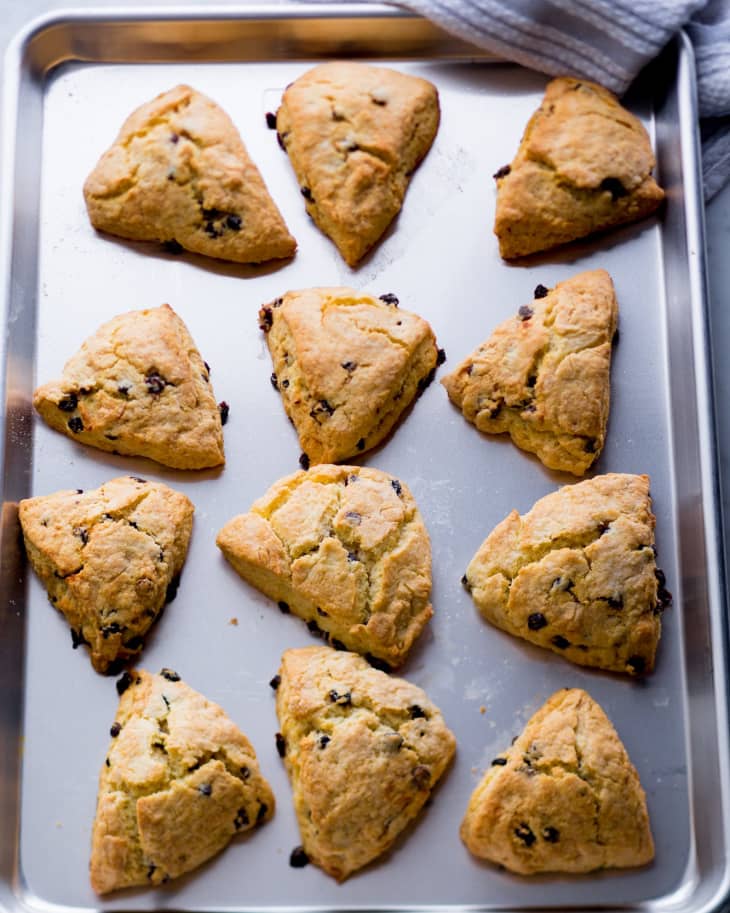How To Make the Best Buttery Scones

Makes12 scones
Scones, buttery baked biscuit-like treats, are descendants of a Scottish oat, barley, or wheat bread. In the U.S. they have increased in popularity over the last 25 years, but scones still tend to get pigeonholed as fancy breakfast or formal high-tea fare. Once you get the hang of the technique of making the dough, you’ll be serving them with ease for snacks, brunches, breakfasts, and even for your own casual tea parties at home.
Two Techniques for Better Scones, Every Time
- Keep it cold: Just like making pie crust or biscuits, the key to making scones flaky is cold everything: cold butter, cold cream, cold eggs, and cold surface if you can. Make sure your hands aren’t too warm, either, you hot-blooded blokes.
- Mixing very little: When it comes to mixing, less is best. Lumps and bumps are the hallmark of scone dough, so leave them be. Overmixing or overworking makes tough, chewy scones, so if you mix until it’s silky-smooth, you are done for. The less-is-best rule is critical every time you add a new ingredient, be it butter, cream, or currants.
Special Flour Makes an Extra-Special Scone
Different flours have different protein amounts and work very differently. Generally, the more protein, the tougher the dough will bake up. For example, breads use bread flour, which has a lot of protein, while cake flour has far less and makes a delicate, fluffy cake. This recipe showcases a combination approach using unbleached cake flour in combination with all-purpose flour to mimic the low-protein quality of pastry flour. If you have actual pastry flour, you can simply substitute it, cup for cup, for all of the flours in this recipe. If you choose to use all unbleached, all-purpose flour, you’ll still be good, but the flavor of the scone and size of the crumb will be distinctly different.
Making It Even Better with Simple, Smart Baking Science
Lemon juice is not part of classic scones, but the zest definitely is. Lemon’s acid tenderizes the dough just a little more, and the juice is also an opportunity to plump the dried currants so they stay moist when cooked.
How To Make Buttery, Melt-in-Your-Mouth Scones
Makes 12 scones
Nutritional Info
Ingredients
- 1/2 cup
dried currants
Juice and zest of 1/2 small lemon (about 2 tablespoons juice and 2 teaspoons zest)
- 1 cup
chilled heavy cream
- 2
large egg yolks
- 2 cups
unbleached cake flour
- 1 cup
unbleached all-purpose flour, plus more for dusting
- 1/4 cup
sugar
- 1 tablespoon
baking powder
- 3/4 teaspoon
baking soda
- 1 teaspoon
salt
- 3/4 cup
(1 1/2 sticks) unsalted butter, cultured preferred, cut into 1/2-inch chunks, chilled
- 3 tablespoons
unsalted butter, melted
- 1/4 cup
Demerara sugar or turbinado sugar, optional
Equipment
Small glass or nonreactive bowl
Small mixing bowl
Plastic wrap
Stand mixer or food processor
Rolling pin
Pastry scraper
Rimmed baking sheet
Pizza cutter or large knife
Pie server
Pastry brush
Instructions
Soak the currants: Place the currants in a small glass or other nonreactive bowl, add the lemon juice and zest, and stir well. Let stand for 35 to 40 minutes. The currants will rehydrate and plump a little.
Prepare for baking: Preheat the oven to 400°F. Spray a rimmed baking sheet with nonstick vegetable oil spray or nonstick baking spray and set aside.
In a small mixing bowl, combine the cream and egg yolks and whisk to combine. Cover with plastic wrap and refrigerate until ready to use.Sift the dry ingredients: Sift the flours, sugar, baking powder, baking soda, and salt into the bowl of a heavy-duty stand mixer fitted with a paddle attachment or the bowl of a food processor fitted with a metal blade.
Add the butter: Scatter the butter chunks over the flour. If you are using a stand mixer, mix at medium-low speed for 30 seconds. If you are using a food processor, process in 8 (1-second) pulses. Either way, the mixture should resemble powdery sand in some spots and coarse sand in others. Do not overmix.
Add the egg mixture: Add the egg mixture and mix at medium speed for 30 to 45 seconds, or process in 4 (1-second) pulses, just until the dough barely comes together. It should be lumpy, with raggedy edges — not smooth at all.
Add the currants: Heavily dust a work surface with all-purpose flour. Scoop the dough out onto it (being careful of the blade if you are using a food processor), scatter the currants and zest on top, and gently mix them in.
Cut the dough: Divide the dough in half. Sprinkle a pinch of flour on top of one of the halves and shape into 6- to 7-inch round with a thickness of about 1/2 inch. Repeat with the other portion of dough. Use a pizza wheel or a large knife to cut each circle into 6 even wedges. Be sure to cut all the way through to the bottom so the wedges are separated. Using a pie server or a spatula, lift the wedges, one at a time, and arrange on the prepared baking sheet, about 1/2-inch to 3/4-inch apart.
Brush with butter: Brush the tops of the scones with the melted butter. Sprinkle with sugar if using.
Bake the scones: Bake until golden-brown on the tops and bottoms, 15 to 18 minutes.
